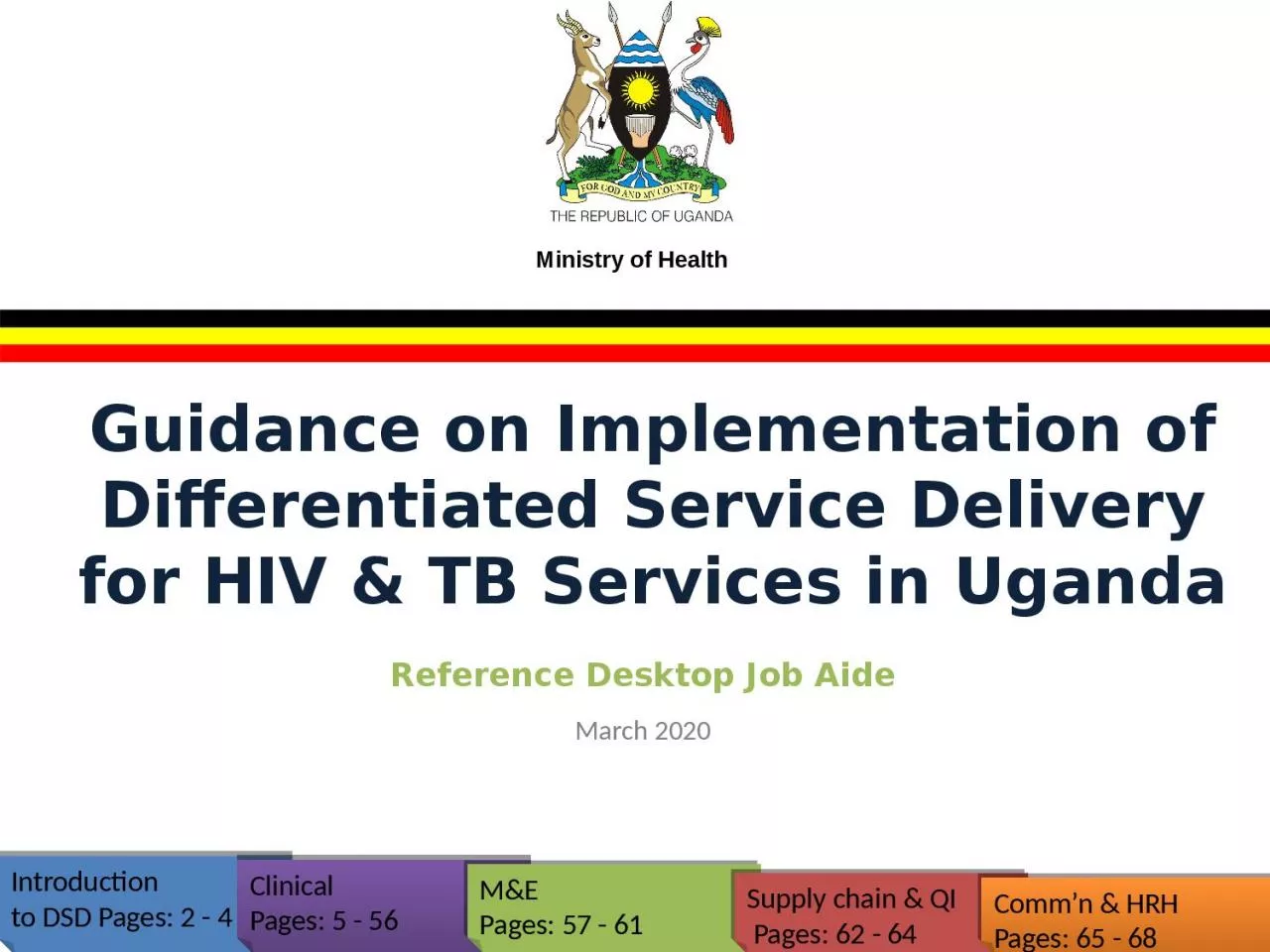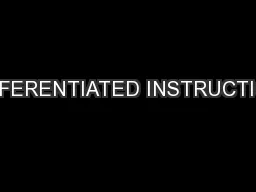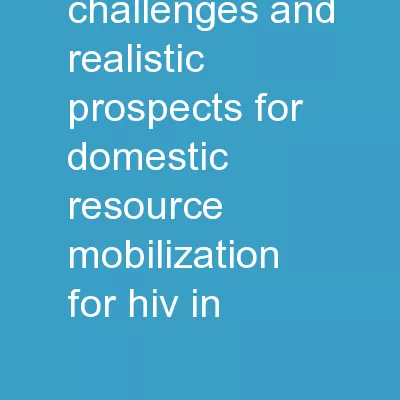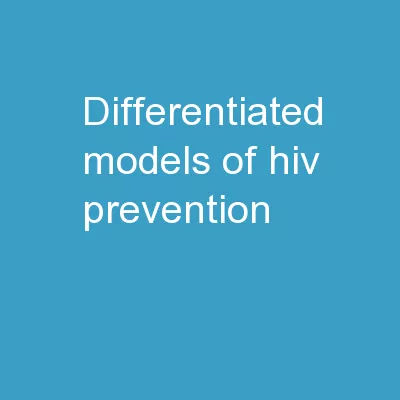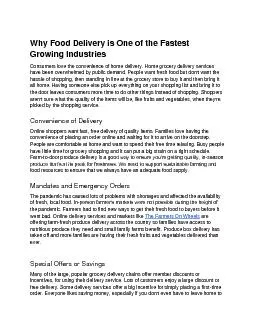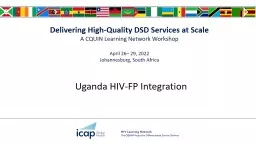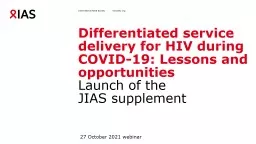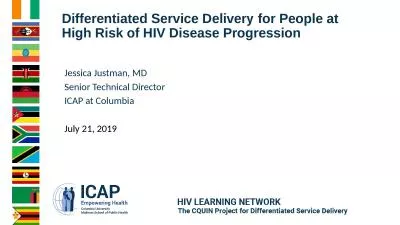PPT-Guidance on Implementation of Differentiated Service Delivery for HIV & TB Services
Author : helene | Published Date : 2024-02-09
Reference Desktop Job Aide March 2020 Introduction to DSD Pages 2 4 Clinical Pages 5 56 MampE Pages 57 61 Supply chain amp QI Pages 62 64 Commn amp HRH Pages
Presentation Embed Code
Download Presentation
Download Presentation The PPT/PDF document "Guidance on Implementation of Differenti..." is the property of its rightful owner. Permission is granted to download and print the materials on this website for personal, non-commercial use only, and to display it on your personal computer provided you do not modify the materials and that you retain all copyright notices contained in the materials. By downloading content from our website, you accept the terms of this agreement.
Guidance on Implementation of Differentiated Service Delivery for HIV & TB Services: Transcript
Reference Desktop Job Aide March 2020 Introduction to DSD Pages 2 4 Clinical Pages 5 56 MampE Pages 57 61 Supply chain amp QI Pages 62 64 Commn amp HRH Pages 65 68. Advanced Express Delivery, is your on time Delivery and Hot Shot Service. Advanced is an efficient Logistics company for all types of Freight, Oil Field, Pipe, Down hole tools, compressor packages, flat bed freight, large or small. By Martha Havens . Associate Director for Elementary . Pacific Union Conference . OUR GOALS FOR TODAY. To walk away understanding the . general components. . of Differentiated Instruction. . To decide where am I, as an educator, in . Organization = Child Family Health International. Local Partner = . Kigezi. Healthcare Foundation. . (a.k.a. KIHEFO). Location = Kabale, Uganda. . Small city in SW part of country, just north of Rwanda. REACHING ALL CHILDREN. IN THE CLASSROOM. Tempest G. Leake. Our Objectives. Understand the model for Differentiated Instruction. Discover strategies to differentiate a lesson based on student interest. By Martha Havens . Associate Director for Elementary . Pacific Union Conference . OUR GOALS FOR TODAY. To walk away understanding the . general components. . of Differentiated Instruction. . To decide where am I, as an educator, in . Zambia and Uganda. Thomas Fagan, Veena Menon, Sayaka Koseki, . and Arin . Dutta. 21st . International AIDS . Conference: . Durban. , . South Africa. July 16, 2016. Current Guidelines and Targets. 2. Total ART Patients. Dr . Nduku. . Kilonzo. CEO, National AIDS Control Council, . Kenya. NATIONAL . AIDS CONTROL . COUNCIL. I AM Team Kenya! Welcome to our Symposia. Ending the AIDS epidemic and Achieving Universal Health Coverage by 2030 in Africa. SAN FRANCISCO, CA.- The Farmers On Wheels online farmers market has been expanding. They’re offering delivery of their new produce boxes all over the country. Visit: https://thefarmersonwheels.com/ Home delivery of farm-fresh produce is steadily growing in popularity with hungry consumers everywhere. Visit: https://thefarmersonwheels.com/ Consumers love the convenience of home delivery. Home grocery delivery services have been overwhelmed by public demand. Visit: https://thefarmersonwheels.com/ Courtesy of the Advanced HIV Disease Implementation Steering Committee (AHD ISC) established by Unitaid and CHAI. Objectives. Part 1: Principles of differentiated service delivery (DSD). Define differentiated service delivery . Dr. Arthur Ahimbisibwe. (MBChB, MPH). Team Lead Adult HIV care and treatment. MOH/ACP-Uganda. Overview of current DSD models of . care. FP . methods in . Uganda. Family Planning methods in DSD . models. Launch of the . JIAS supplement. 27 October 2021 webinar. Differentiated service delivery for people on second-line antiretroviral therapy: Evidence from KwaZulu-Natal, South Africa. Lewis L, Sookrajh Y, Gate K, Khubone T, Maraj M, Mkhize S, Hermans LE, Ngobese H, Garrett N, Dorward J. Jessica Justman, MD. Senior Technical Director. ICAP at Columbia. July 21, 2019. The Challenge of HIV Mortality . HIV treatment scale-up has been remarkable . The annual number of deaths amongst PLHIV globally has fallen from a peak of 1.7M in 2005 to 770K in 2018.
Download Document
Here is the link to download the presentation.
"Guidance on Implementation of Differentiated Service Delivery for HIV & TB Services"The content belongs to its owner. You may download and print it for personal use, without modification, and keep all copyright notices. By downloading, you agree to these terms.
Related Documents

